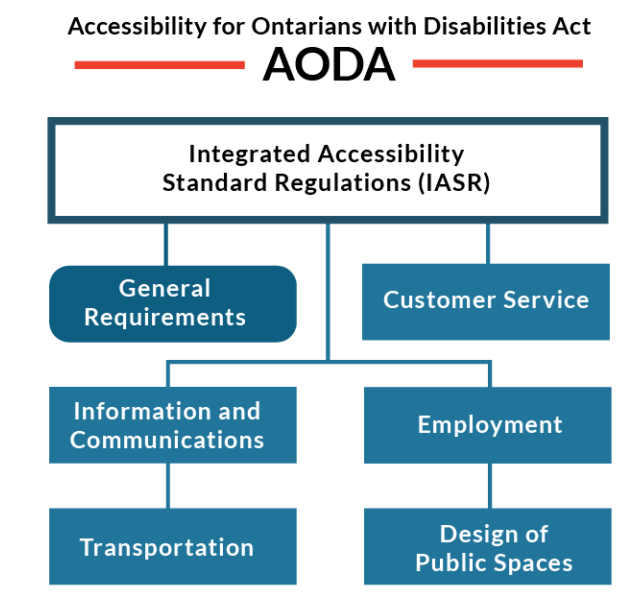AODA and The Learning Environment
In 2005, the Ontario Government established the Accessibility for Ontarians with Disabilities Act (AODA) with the goal of making Ontario fully accessible by 2025. The focus was to ensure persons with disabilities could fully participate in everyday life in our communities and the economy.
Educational institutions operating in Ontario have a legal duty to take steps to prevent and respond to breaches of the Ontario Human Rights Code (OHRC). This responsibility includes maintaining accessible, inclusive, discrimination and harassment-free education environments that respect human rights. The Integrated Accessibility Standards help with doing just that.
Watch the video below by OntarioUniversities for an overview of the AODA and how it applies to educators.
The AODA established the Integrated Accessibility Standard Regulations (IASR), a grouping of legal requirements that institutions must follow to help identify, remove, and prevent barriers faced by persons with disabilities. These requirements are divided in two categories: General Requirements and Accessibility Standards.
 Figure 1: “About the AODA” by Accessibility Services Canada
Figure 1: “About the AODA” by Accessibility Services Canada
General Requirements
The General Requirements include training, procurement, planning, accountability (reporting), and policies and processes.
Accessibility training for employees and volunteers is mandatory under the AODA. If you haven’t received training yet, check with your supervisor or your manager for details and ensure you have taken it.
Accessibility Standards
At this time, the Accessibility Standards comprises of five requirements necessary to ensure a basic standard of accessibility in the following key areas of day-to-day life:
- Customer service
- Information and Communications
- Employment
- Transportation
- Design of Public Spaces (Built Environment)
Note: Each standard is alternatively being reviewed every five years. When deemed necessary, requirements and implementation timeframe are added or modified. Changes to the standards may require institutions to re-train all employees on its developments.
Roles and Responsibilities of Educators under the IASR
Following the requirements under the IASR in the learning environment can take many forms, such as accessible information and communications. The information and communications standard outlines requirements for creating, providing, and receiving information and communications in ways that are accessible for people with disabilities. This includes:
- Websites and web content
- Educational training resources and materials
- Training to professors and other educators
- Libraries of educational and training institutions
Select the tabs below to learn about each of these areas.
Remember, accessibility is a proactive solution to providing equal access for all. It is the baseline of equal service. Accessibility is what we should expect to be ready for us without asking or planning ahead. It can be provided by following an easy-to-implement set of standards and practices that make “adaptation” unnecessary. We can benefit from accessibility without announcing or explaining our disabilities (Pulrang, 2013).
In the next section we’ll explore why it’s important to take a proactive approach to accessibility in your course design.
References
Accessibility Services Canada. (n.d.). About the AODA [Chart]. https://accessibilitycanada.ca/aoda/
Ontario Human Rights Commission. (2004). Guidelines on accessible education. http://www.ohrc.on.ca/sites/default/files/attachments/Guidelines_on_accessible_education.pdf
OntarioUniversities. (2013, Dec 3). Discover: An Educator’s Introduction to the AODA [Video]. YouTube. https://youtu.be/4AxaWGbf4mk
Pulrang, A. (2013, Aug 17). Accessibility vs. Accommodation [Blog post]. http://disabilitythinking.blogspot.com/2013/08/accessibility-and-accommodation.html
Attribution Statement
This chapter is an adaptation of Chapter 3.2. of Universal Design for Learning (UDL) for Inclusion, Diversity, Equity, and Accessibility (IDEA) by Darla Benton Kearney and is used under a CC BY 4.0 International License. Changes include removal and rewriting some of the passages and adding original material.
